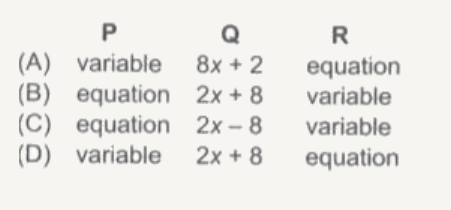Fill in the blanks.
(i) An expression with a variable, constant and the sign of equality is called an P –––––.
(ii) 8 more than 2 times the number x can be written in algebraic form as Q ––––––.
(iii) An equation is a condition on a R ––––––.

The correct Answer is:B
Step by step video & image solution for Fill in the blanks. (i) An expression with a variable, constant and the sign of equality is called an underline(" P "). (ii) 8 more than 2 times the number x can be written in algebraic form as underline(" Q "). (iii) An equation is a condition on a underline(" R "). by Maths experts to help you in doubts & scoring excellent marks in Class 6 exams.
Updated on:21/07/2023Topper's Solved these Questions
Similar Questions
Get the algebraic expressions in the following cases using variables, constants and arithmetic operations.
(i) Subtraction of z from y.
(ii) One-half of the sum of numbers x and y.
(iii) The number z multiplied by itself.
(iv) One-fourth of the product of numbers p and q.
(v) Numbers x and y both squared and added.
(vi) Number 5 added to three times the product of numbers m and n.
(vii) Product of numbers y and z subtracted from 10.
(viii) Sum of numbers a and b subtracted from their product.
View SolutionP @ Q means P is greater than Q.
P @–– Q means P is either greater than or equal to Q.
P = Q means P is equal to Q.
P © Q means P is smaller than Q.
P ©– Q means P is either smaller than or equal to Q.
Statements: L©–K,M©N,K=M
Conclusions: I. N @ L II. K©–N
View Solution
Knowledge Check
Fill in the blanks by choosing the correct option .
order of the reaction is the x–– of the powers to which concentration terms are raised in expermentally determined rate equation . The unit of first order rate constant is Y–– the unit of first order rate constant when concentration is measured in terms of pressure and time in muutes is Z––AX→ product ,Y→molL−1 time −1,Z→atm−1minBX→sum ,Y→mol−1,Z→atm−1minCx→ product ,Y→Lmol−1,Z→atm−1minDx→ sum ,Y→time−1,Z→−1minFill in the blanks by choosing the correct option. Order of the reaction is the X–– of the powers to which concentration terms are raised in experimentally determined rate equation. The unit of first order rate constant is Y––. The unit of first order rate constant when concentration measured in terms of pressure and time in minutes is Z––
AX→ product, Y→molL−1time−1,Z→atmmin−1BX→ sum Y→Lmol−1time−1,Z→atmmin−1CX→ product, Y→Lmol−1,Z→atmmin−1DX→ sum, Y→tim−1,Z→min−1P @ Q means P is greater than Q.
P @–– Q means P is either greater than or equal to Q.
P = Q means P is equal to Q.
P © Q means P is smaller than Q.
P ©– Q means P is either smaller than or equal to Q.
Statements: I©–J,K=J©–L,H@––J
Conclusions: I. J = L II. I@––HAIf only I is trueBif only conclusion II is trueCif either conclusion I or II is trueDif either I nor II is true
Fill in the blanks with appropriate choice .
Bond order of N+2 isP–– while that of N2 is Q–– .
Bond order of O+2 is R–– while that of O2 is S––.
N-N bond distance T–– when N2 changes to N+2
and when O2 changes to O+2 , the O-O bond distance U––.
View SolutionFill in the blanks.
(i) Sum of rational and irrational is _____ P ___.
(ii) Square root of an odd number is ____Q___ .
(iii) Number ending with _____R____ number of zeroes is never a perfect square.
View SolutionP @ Q means P is greater than Q.
P @–– Q means P is either greater than or equal to Q.
P = Q means P is equal to Q.
P © Q means P is smaller than Q.
P ©– Q means P is either smaller than or equal to Q.
G@––F,Dunderline"©"E,E=F
Conclusions: I. E © G II. E = G
View SolutionP ⊗ Q means P is greater than Q.
P ©– Q means P is either greater than or equal to Q.
P = Q means P is equal to Q.
P @ Q means P is smaller than Q.
P underlinecancel("@") Q means P is either smaller than or equal to Q.
Statements: A©–N,J∘U,S⊗A,J=N
Conclusions: I. J @ S II. U⊗N
View SolutionP ⊕ Q means P is greater than Q.
P ©– Q means P is either greater than or equal to Q.
P = Q means P is equal to Q.
P @ Q means P is smaller than Q.
P underlinecancel("@") Q means P is either smaller than or equal to Q.
Statements: L ©– A, S @ E, A = S, G ⊕ L
Conclusions: I. A @ E II. G⊕A
View Solution
